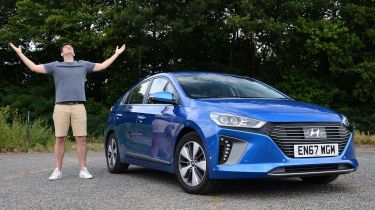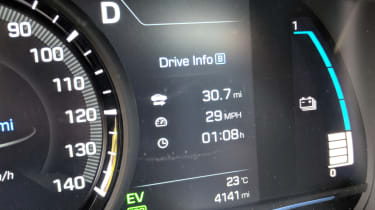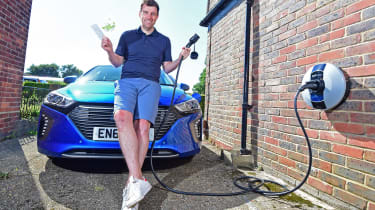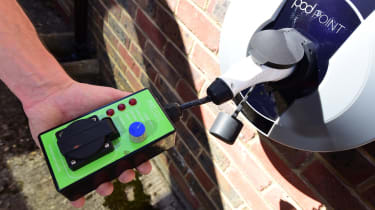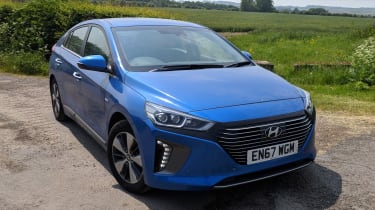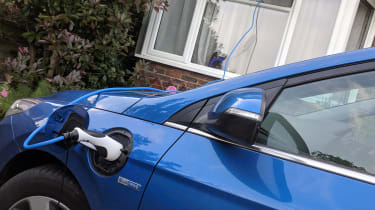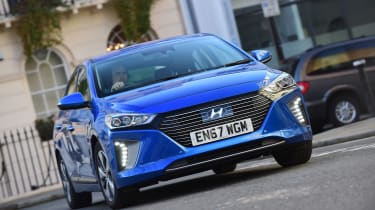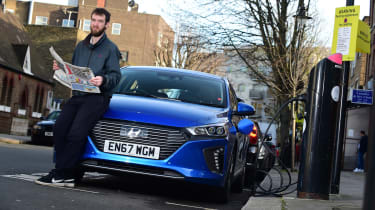Long-term test review: Hyundai Ioniq Plug-in Hybrid
Final report: we look back at our six months with Hyundai Ioniq Plug-in Hybrid hatch
Our Hyundai Ioniq Plug-in Hybrid has been an agreeable companion on our test fleet over the past six months. Hybrid technology is going mainstream with cars like this and the South Korean brand is well placed to plug in for the ride.
Mileage: 6,788Economy: 82.1mpg
Name a hybrid car. Assuming you haven’t drawn a complete blank, there’s a good chance the model that sprang to mind was the Toyota Prius. Through its four generations the Prius has come to define ‘hybrid’ around the world, but its position is under threat.
The range of hybrid cars available is growing rapidly. Buyers have nearly 90 hybrid models to choose from in the UK today, and among the more recent arrivals, the Hyundai Ioniq is targeting the Prius more overtly than any other.
• Best plug-in hybrid cars on sale
We’ve been running an Ioniq Plug-in Hybrid for six months and as it prepares to sign off from our test fleet, it’s time to weigh up exactly what we’ve got.
Firstly, to define it purely as Hyundai’s ‘Prius killer’ misses the point. The Ioniq, like the Prius, is a compact family car. It’s an alternative to the Ford Focus, Skoda Octavia and Volkswagen Golf that’s becoming more relevant to buyers as hybrid tech goes mainstream and diesel is increasingly (often unfairly) sidelined.
More reviews
Car group tests
In-depth reviews
Road tests
- New Hyundai Ioniq Electric 2020 review
- New Hyundai Ioniq Hybrid 2019 review
- New Hyundai Ioniq Plug-in 2017 review
- Hyundai Ioniq autonomous ride review
Used car tests
Secondly, as with any car, but probably to a greater extent with a plug-in hybrid, how effective it is in the family car role hinges on how you use it.
You can get the Ioniq as a hybrid, plug-in hybrid or pure-electric car, and it’s the first model in the world to make all those three powertrain options available. Hybrid tech is a stepping stone between internal combustion and electric cars, and the plug-in hybrid offers a blend of standard hybrid and EV qualities. You can charge the Ioniq from a mains socket in around six hours, but a 3.6kW domestic wall charger does the job in less than three.
On a full battery, the Ioniq will cover a consistent 30 miles in pure-electric mode, using no petrol and opening up the possibility of doing your 15-mile twice daily school run solely on electric power.
Got somewhere to charge at work? Then a 60-mile round-trip commute could be done without ever exploding a drop of unleaded. It’s why the Ioniq, the Prius and other plug-ins bring low VED tax bills and significant company car tax benefits over the usual suspects, as well as enjoying Congestion Charge exemption in London.
Of course, once your 30 miles of EV gliding are spent, the Ioniq operates as a normal hybrid, but the hefty battery under the boot floor means it weighs about 200kg more than a diesel VW Golf. While we’ve been averaging well over 80mpg with regular charging and lots of short EV-only journeys, it’s noticeable that longer 200-mile round trips with no charging options at the destination take a big bite out of that average figure.
Returns can easily drop closer to 50mpg under that kind of use, at which point an economical diesel would be a match for the hi-tech Ioniq. The official claimed 256.8mpg economy figure only serves to underline the problem with the old NEDC economy and emissions tests where plug-in hybrids are concerned.
So the cost question is intrinsically linked to how you use Hyundai’s plug-in hybrid. If you can operate it as an electric car with occasional capacity to travel further, it’s impressively efficient and cost effective.
High-mileage drivers will have more trouble justifying it over traditional choices, but if you’re a company car tax payer, the balance swings back towards the Ioniq, because CO2 emissions of 26g/km put the Hyundai in the lowest Benefit-in-Kind (BiK) tax band.
Alongside the Kona Electric, the car is a technological flagship for Hyundai and it hasn’t held back with the standard kit or the quality of the cabin. Our Premium SE has air-conditioned and heated front seats, leather, an eight-inch touchscreen with sat-nav and wireless phone charging.
Rear legroom is great and while the ISOFIX points could be easier to access, the doors open wide for fitting a child seat. The major drawback for families is the 341-litre boot; a Golf offers 40 litres more.
Update: Hyundai Ioniq Plug-in Hybrid
The Hyundai Ioniq Plug-in hybrid is returning great economy, and a newly installed Pod Point has cut charging times
Mileage: 6,056
Economy: 82.1mpg
It feels great to be a member of the EV revolution. The windows are shut and the extension lead is in the garage, yet our Hyundai Ioniq plug-in hybrid is outside happily suckling from the national grid, courtesy of a new home charging point from Pod Point.
The lack of a convenient place to charge at home is one of the biggest problems with plug-in car ownership. While anyone not lucky enough to have off-street parking is still likely to baulk at this hurdle, we’re over it. Full-on 7kW fast charging remains out of reach because the ancient ceramic fuse in my house isn’t up to the job, but once that’s replaced Pod Point will up the power remotely.
Aside from no longer having to run a cable out of the window, it has markedly speeded up the charging process. The Hyundai was taking six hours to draw a full charge from a household socket, but the Pod Point charger is delivering the same in less than three hours, even though it’s running at just 3.6kW until the fuse is replaced. We’ve been getting 30 miles of pure electric driving on a charge, too.
It costs £779 to get a basic wall charger like ours from Pod Point, but the Government’s Electric Vehicle Homecharge Scheme (EVHS) cuts £500 from that. At £279, it’s good value.
And with a proper charging point, the Ioniq comes into its own. Charging overnight means the batteries are always full in the morning and the first 30 miles can be done on electricity alone, so you can save your pure EV hit until you encounter urban traffic.
It works seamlessly as A to B transport or a commuting tool with a spacious cabin and a well conceived control interface.
Update: Hyundai Ioniq
The Hyundai Ioniq Plug-in hybrid family car is proving a hit on our long-term fleet
Mileage: 4,407
Economy: 80.2mpg
The winds of change are giving the car industry quite a buffeting just now and it seems highly likely that once the turmoil has subsided, the big change motorists are going to have to get used to is the simple act of plugging their cars in. I’m getting into the groove with our Hyundai Ioniq, one of the small but rapidly growing number of models on sale today that will let you practice for the electric revolution.
Our Ioniq is a plug-in hybrid; we haven’t gone full EV and neither should you unless you’re sure it suits your lifestyle. We haven’t been religiously topping up the battery every night, either, mainly due to the lack of off-street parking, scarcity of charging points and time constraints that are central to much of the general uncertainty around plug-in cars. But charged or not, the Ioniq really is very agreeable.
• Best plug-in hybrid cars on sale
The Government has floated plans for every car on sale to be capable of a 50-mile electric range by 2040 and the Ioniq Plug-in will do 30 miles consistently today. If you had a short, urban commute and good charging access, you might never need to fire up the old internal combustion engine.
Yet the Hyundai works well whether it’s exploding petrol in its cylinders or not. It’s a genuinely roomy four-seat family car that feels well built and makes its clever underlying tech easy to use. The balance between buttons and touchscreen menus is well judged, with the important stuff easy to access quickly. Rear legroom is particularly good, as is the range of adjustment in the driving position. The modest boot capacity might spark concerns for family buyers, but the plug-in hybrid powertrain is nothing to be afraid of.
Update: Hyundai Ioniq Plug-in
Hyundai Ioniq Plug-in hatch still ticks all the right boxes
Mileage: 3,051
Economy: 62.0mpg
Electrified vehicles have been known to come with the odd compromise over the years, but our Hyundai Ioniq PHEV is acquitting itself really well in everyday use.
The Ioniq is an unashamed rival for the Toyota Prius, and it has a similar profile – a result, no doubt, of prioritising aerodynamic efficiency over pretty much everything else.
• Best plug-in hybrid cars on sale
However, it still works in everyday use; our picture editor Dawn Grant thought she was about to be caught out when her daughter needed a lift with her bicycle recently. But she found the Hyundai’s boot more than big enough to accommodate the two-wheeled transport. And that was even with the various charging cables still strewn over the boot floor.
I’ve also been putting the Ioniq’s capacity to the test, but on cabin space instead of boot capacity. I’ve recently hopped out of a VW e-Golf and the Ioniq’s lengthy wheelbase means it matches that car for rear accommodation. My young son is able to stretch his legs without doing too much damage to the rear of the front passenger seat – and you can’t say that about every family hatchback currently on sale.
Of course, the Ioniq is still fundamentally about fuel efficiency, and so it is with some regret that we must report that our car did go through a period without regular charging.
But now we’re back into the swing of things, thanks to a cheap adaptor that allows us to connect to some of the ‘commando’ sockets that are still in use in London. The Ioniq gets more than enough juice during a few hours at 13 amps. And the fuel economy figure is heading up as a result; we’re way beyond 60mpg now, and still climbing.
First report: Hyundai Ioniq Plug-in
The Hyundai Ioniq Plug-in Hybrid hatchback charges on to our fleet
Mileage: 1,311Economy: 53.8mpg
Electric cars are grabbing all the headlines at the moment, and it’s easy to see why. They offer rock-bottom running costs with the benefit of a great driving experience as well.
But fully electric vehicles are still in their infancy, and they don’t provide enough range for most people to run one as their only vehicle. That’s where the latest addition to our fleet comes in.
The Hyundai Ioniq Plug-in Hybrid combines its 45kW electric motor with a traditional 1.6-litre petrol engine, which means there’s no range anxiety; simply fill up with petrol as you would with a normal car, and you can drive the length and breadth of the country without the worry that you won’t be able to charge up en route.
That’s not the point of this plug-in hybrid, though, because since the engine has a heavy battery to pull around, the petrol powerplant isn’t particularly economical on its own. Where the Ioniq really starts to click is for someone like me.
I live in Surrey, but the Auto Express office is around 30 miles away in central London. That means the Hyundai’s all-electric range of 39 miles will take me all the way to the office car park without the engine even coming on.
However, I don’t commute into town all the time: I also spend some days driving around the country conducting the road tests you read each week – so even if I find myself with 100 miles or more to cover in the morning, I won’t have to dig out another means of transportation.
For the Ioniq to work perfectly, though, it needs to be charged both at home and while I’m at work. It takes around four-and-a-half hours for a full charge on a home wall box (Hyundai’s recommended 7kW POD Point is free of charge thanks to a Government grant) or public point, but 12 hours via a three-pin plug. As our work car park has only a single fast charger, which is often already taken, I’ve had to head out and plug in at one of London’s many on-street stations.
The Ioniq’s sat-nav comes with a built-in list of the nearest charging points, so it’s easy to select one from the list and head straight there.
Unfortunately, the capital is such a hotspot for EVs that the nearest free charger is often a long way from the office. Even with a high concentration of public points, a plug-in hybrid relies on access to private, or at least reliably available, charging. As we spend more time with the car we’ll report on how well it fulfils its brief.
Official figures claim economy of 256.8mpg. Our goal isn’t to see if the car can match that, but to find out how well the Ioniq combines the best of EVs and traditionally fuelled models.
*Insurance quote from AA (0800 107 0680) for a 42-year-old in Banbury, Oxon, with three points.
Get the latest electric car news, reviews and analysis on DrivingElectric.com

